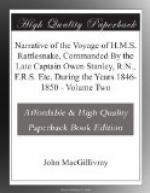This very remarkable mollusk was taken in the towing net off Cape Byron, on the east coast of Australia, in latitude 28 degrees 40 minutes South, fifteen miles from the shore. It was floating and was apparently gregarious. Mr. Macgillivray states that it is furnished with a float in the manner of Ianthina. The largest specimens measure rather less than two lines in diameter. The shell is of a yellow horn colour (as is also the operculum) thin and transparent. It bears a striking resemblance to our much more minute Jeffreysia opalina. The four tentacula and the form of the very peculiar operculum also seem to indicate considerable affinity with the genus Jeffreysia of Alder, and an examination of the remains of the tongue extracted from a dried specimen showed an arrangement and form of the lingual denticles very closely resembling that exhibited by Jeffreysia. On the other hand, the very distinct and long siphonal tube delineated in Mr. Macgillivray’s drawing, taken when the animal was alive, would seem to refer this genus to some family probably near to Cancellaridae. It is certainly entirely distinct in every respect from any known Gasteropod. It is a form of very great interest to the geologist, for in it we see the nearest representation of certain palaeozoic (especially Lower Silurian) univalves hitherto referred to Littorina, but which, judging from their associates and the indications afforded by the strata in which they are found, were assuredly either inhabitants of deep water or floaters in a great ocean like the Pacific.
I have dedicated this most interesting creature to my friend Mr. Macgillivray, its discoverer, whose researches have been productive of so much new and valuable contributions to all departments of zoological science.
I have named the species M. pelagica. Tab. 3 fig. 8. a, b, c, d. (Mus. Brit. and Geol.)
New Genus—CHELETROPIS, Forbes.
Shell spiral, turbinate, dextral, imperforate, spirally ridged or double-keeled and transversely wrinkled; spire prominent, its nucleus sinistral; aperture ovate, canaliculated below, its outer margin furnished with two claw-like lobes, the one central and formed by a prolongation of the margin between the keels of the body whorl, the other smaUer and nearer the canal; peristome thickened, reflexed, forming a conspicuous margin.
Operculum none ?
Animal unknown, but certainly floating, and probably pteropodous. This I infer from its habits, and from the analogy of the shell with Spirialis. (Mus. Brit. & Geol.)
The only known species, C. huxleyi (dedicated to Mr. Huxley, Assistant Surgeon of the Rattlesnake, and now eminent for the admirable anatomical researches among marine invertebrata which he conducted during the voyage) is very minute, being not more than the 1/24th of an inch in diameter. It is translucent and of a brownish-white hue. Its aspect is that of a Turbo in miniature. The whorls are tumid,




